Review: 'The Right to Arm Bears', by Gordon R. Dickson
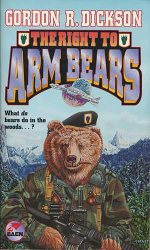 This “novel” collects Dickson’s three light space-opera adventures about humans, the bearlike Dilbians, and the jovial-but-sinister Hemnoids: Spacial Delivery, first published as a novel by Ace Books, November 1961, 123 pgs.; Spacepaw, first published as a novel by G. P. Putnam’s Sons, February 1969, 222 pgs.; and “The Law-Twister Shorty”, a novelette in The Many Worlds of Science Fiction, edited by Ben Bova (E. P. Dutton, November 1971, pp. 51-105).
This “novel” collects Dickson’s three light space-opera adventures about humans, the bearlike Dilbians, and the jovial-but-sinister Hemnoids: Spacial Delivery, first published as a novel by Ace Books, November 1961, 123 pgs.; Spacepaw, first published as a novel by G. P. Putnam’s Sons, February 1969, 222 pgs.; and “The Law-Twister Shorty”, a novelette in The Many Worlds of Science Fiction, edited by Ben Bova (E. P. Dutton, November 1971, pp. 51-105).
Planet Dilbia is in a crucial location for both humans and their adversaries, the Hemnoids. Therefore making friends with the Dilbians and establishing a human presence there is of the utmost importance, which may be a problem, since the bearlike Dilbians stand some nine feet tall, and have a high regard for physical prowess. They're not impressed by human technology, either. A real man, er, bear doesn't need machines to do his work for him. But Dilbians are impressed by sharp thinking, and some have expressed a grudging admiration for the logical (and usually sneaky) mental maneuvers that the human "shorties" have used to get themselves out of desperate jams. Just maybe that old human craftiness will win over the Dilbians to the human side. If not, we lose a nexus, and the Dilbians will learn just how unbearable Hemnoids can be.... (back-cover blurb)
Riverdale, NY, Baen Books, December 2000, 431 pages, 0-671-31959-0, $6.99
These three adventures betray their Cold War time-period. The Humans (Americans) and the totalitarian Hemnoids (Soviets) are both expanding through the galaxy, trying to win over the unaligned planets like Dilbia to their spheres of influence.
‘We must influence Dilbians like that chap or the Hemnoids are going to get the inside track on this planet. And the Dilbian system, as I’m sure your hypno training didn’t omit to inform you, is absolutely necessary as a supply and reequipment stage for further expansion on any large scale beyond the Belt Stars. If the Hemnoids beat us out here, they’ve got the thin end of a wedge started that could eventually chop our heads off.’ (pgs. 6-7)
The problem is that the Dilbians resemble nine-foot-tall lanky Kodiak bears, and while they prefer to stay neutral in the rivalry between those whom they call the Shorties and the Fatties, they naturally feel more akin to the eight-foot-tall Hemnoids:
… John saw, a sort of enormous robed, Buddha-like parody of a human being. The Hemnoid was a good eight feet in height, enormously boned, and while not as tall as the Dilbians themselves, fantastically padded with heavy-gravity muscles. (p. 5)
Compared to the Dilbians and the Hemnoids, the humans look like puny weaklings. Also, humans smell bad to Dilbians. The Dilbians’ attitude to the humans is one of friendly but condescending superiority.
The Dilbians also have a fondness for mildly insulting humorous names for themselves and for anyone else who comes to Dilbia, such as Daddy Shaking Knees, Two Answers, and Split Nose. The Hemnoid ambassador is dubbed the Beer-Guts Bouncer, a name of approval to the beer-loving Dilbians. Humans on Dilbia usually don’t like the names they are given.
In Spacial Delivery (expanded from “The Man in the Mailbag”, Galaxy, April 1959), young John Tardy, who expects to become an interstellar expert in biochemistry, is diverted to Dilbia instead. A human woman, Greasy Face (she wears a lot of makeup) has been kidnapped as a pawn in an affair of honor by the Streamside Terror, the leading brawler of the Dilbian hillbilly community of Clan Hollows.
‘You knows why they call him the Streamside Terror, don’t you, Half Pint? It’s because he likes to do his fighting alongside a stream, and pull the other man in the water and get him drowned.’ (p. 24)
Tardy was an Olympic decathlon champion while he was in college, and Earth’s Alien Relations Office figures that he has the best chance of rescuing Greasy Face (Miss Ty Lamorc, a sociologist studying the Dilbians) if it comes down to a physical fight with the nine-foot bear.
To get Tardy to the remote community where she is held, the Human Embassy decides to mail him: to have the local Dilbian postman carry him in his mailsack.
‘Hill Bluffer, that’s my name and trade! Anything on two feet walk away from me? Not over solid ground or living rock! When I look at a hill, it knows it’s beat; and it lays out flat for my trampling feet!’ (p. 13)
A special saddle-like harness is rigged for Tardy to ride on Hill Bluffer’s back, which neither of them like but is better than riding in a mailbag.
During their trek across the countryside through one small Dilbian hamlet after another, Tardy (dubbed the Half-Pint Posted) and Hill Bluffer become Odd-Fellow friends. Tardy, assigned to win the Dilbians’ support for the Humans, comes to respect their independence, their stiff sense of honor, and their casual contempt for formality and bureaucracy. He also gradually learns that there is more to the Streamside Terror’s kidnapping of Greasy Face than the official story. He has near-fatal accidents; he discovers that the Streamside Terror’s girl friend, Boy Is She Built, is following and trying to sabotage them to protect her lover; that a Hemnoid agent, Tark-ay, is helping her for his own reasons; and more. By the time he and Hill Bluffer catch up to the Streamside Terror, Tardy has iron-clad reasons both to fight and to avoid fighting, as well as the seemingly impossible dilemma of how a six-foot human can defeat a nine-foot clawed Dilbian experienced battler. Tardy takes advantage of the fact that Dilbians respect intelligence and cunning even over physical strength, and the Hemnoids are thwarted.
Bill Waltham, the protagonist of Spacepaw, is introduced similarly to John Tardy. He has studied to become a terraforming engineer – “He thought again of the great symphony of engineering and development that was a terraforming project – changing the surface and weather of a whole world to make it humanly habitable” (p. 142) – and he is disappointed to be drafted instead into the Agricultural Assistance Program’s Project Spacepaw as a sort of interstellar Peace Corps instructor to Dilbian farmers.
This is a spade. You hold it by this end. You stick the other end in the earth. Yes, deep in the earth. Then you tilt it, like this.
Etc. Waltham can imagine himself wasting the next two years among the giant bearlike peasants of the village of Muddy Nose.
But his life on Dilbia turns out to be much more of a whirlwind than that. He arrives in Muddy Nose to find it full of wild-whooping outlaws who plan to hold him for ransom. He is saved by the Hill Bluffer, who names him Pick-and-Shovel and expects him to duplicate the Half-Pint Posted’s feat by rescuing another Human female captive, Dirty Teeth (Anita Lyme, the Humans’ Agricultural Resident’s trainee assistant), from Outlaw Valley. Hill Bluffer is not alone. Dirty Teeth has been kidnapped by the outlaws because she is a rabble-rousing Women’s Libber who has been stirring up the women-folk of the Dilbians’ patriarchical society, and those women, led by the militant Sweet Thing, expect Pick-and-Shovel to liberate her from outlaw chief Bone Breaker immediately.
‘And none of that sissy lowland stuff with swords and shields,’ put in the Hill Bluffer. ‘Just honest, man to man, teeth, claws, and muscle. (p. 398)
Bone Breaker’s outlaws are being secretly manipulated by a Hemnoid agent, Mula-ay (Barrel Belly) …
Spacepaw is basically Spacial Delivery all over again and longer. But the details are considerably different (plus the added exasperation of Pick-and-Shovel’s having to live up to the exaggerated reputation of the Half-Pint Posted), and they are colorfully humorous enough that you will not mind reading the story twice.
“The Law-Twister Shorty” is Malcolm O’Keefe, a bewildered high-school student inexplicably drafted to quietly “rescue” three human tourists that an imperious young Dilbian, Gentle Maiden, has decided to “adopt” and, essentially, keep as pets in her community of Clan Water Gap. Both the Humans and Hemnoids have a strict noninterference treaty with the Dilbians at this time, except for rigidly-supervised exceptions such as this tourist party; and if the Hemnoids can prove the presence of humans in Water Gap after the tourist group has left, even as unwilling prisoners, they can gleefully accuse the Humans galactically as treaty-breakers. O’Keefe’s (or Law-Twister’s; he’s a school debating champion) assignment is complicated by the fact that Gentle Maiden’s boyfriend and protector is Iron Bender, Water Gap’s strongest young male, who is honor-bound to defend her actions. Neither Law-Twister nor Iron Bender are keen to be forced into a “let’s you and him fight” situation, so with the canny suggestions of Hill Bluffer and Water Gap’s elders who want to avoid a public incident, they find a way to defuse the crisis.
The book’s jokey title and Richard Martin’s cover are very amusing, but they totally misrepresent the Dilbians as to the amount of clothes they wear, and to their preference for “verbal fencing” which favors outwitting an adversary rather than fighting. See the “imitation Ed Emshwiller” (not by Emsh?) anonymous cover of Ace Books’ Spacial Delivery for a more accurate depiction. In fact, while I usually show only the first-edition covers in my reviews, here is a gallery of the previous editions of Spacial Delivery and Spacepaw. Note how the artist of the “imitation Ed Emshwiller” cover, Stephen Hickman, and Tom Kidd have tried to illustrate the Dilbians accurately (although usually still depicting them as giant bears rather than “bearlike”); while Leon Gregori and Paul Lehr have not bothered -- Lehr(?) even depicting the Dilbians as gorillas! Wayne Barlowe, in his 1979 Barlowe’s Guide to Extraterrestrials, has done the best job of drawing them as they are supposed to look.
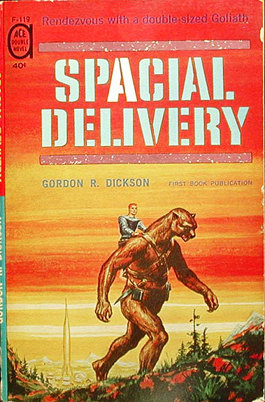 Spacial Delivery – Ace Books, “imitation Ed Emshwiller”, November 1961 [reverse] |
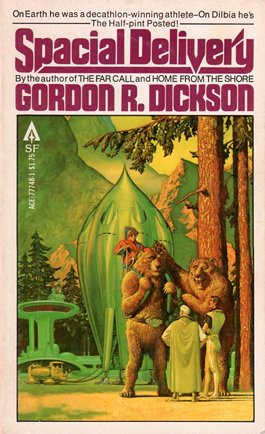 Spacial Delivery – Ace Books, Stephen Hickman, January 1979 |
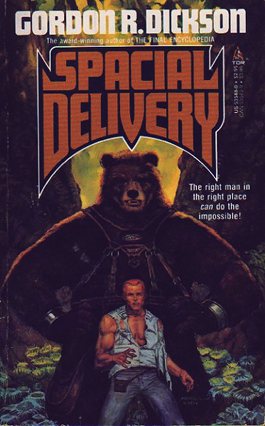 Spacial Delivery – Tor Books, Tom Kidd, May 1987 |
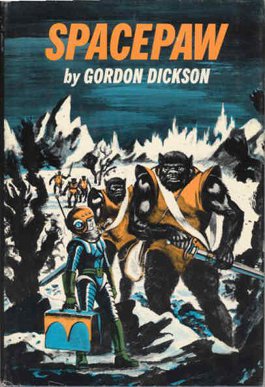 Spacepaw – G. P. Putnam’s Sons, Leon Gregori, February 1969 |
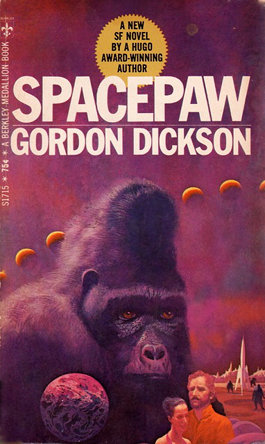 Spacepaw – Berkley Medallion, Paul Lehr(?), July 1969, gorilla |
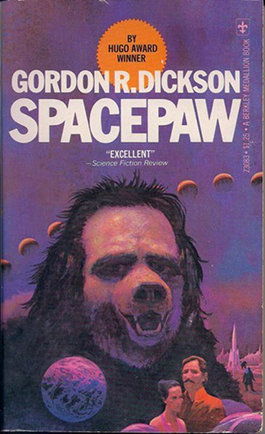 Spacepaw – Berkley Medallion, Paul Lehr, March 1976, pigbear |
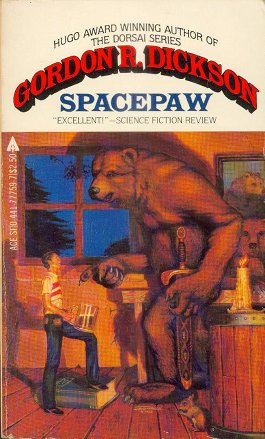 Spacepaw – Ace Books, Tom Kidd, March 1983 |
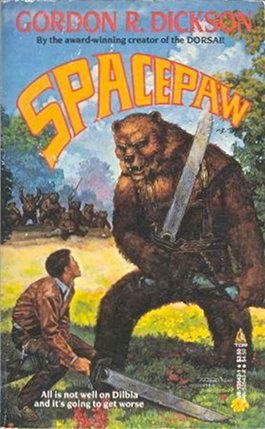 Spacepaw – Tor Books, Tom Kidd, November 1988 |
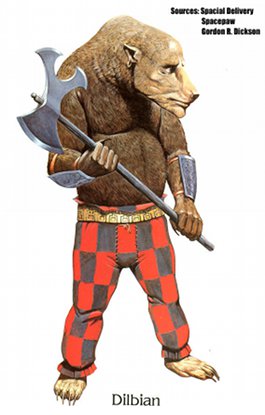 Barlowe’s Guide to Extraterrestrials – Wayne Barlowe |
About the author
Fred Patten — read stories — contact (login required)a retired former librarian from North Hollywood, California, interested in general anthropomorphics
Comments
I read this in 2001 and gave it 3 out of 5 stars on amazon.com, along with the following review:
I might give it a more favorable review if I were to reread it now, especially since I seem to have been rather pedantic at the time about scientific plausibility of the setting, where now I could just let go and rate it based on whether the stories are entertaining.
Your discussion of the cover art reminds me of something Lisanne Norman said about the covers of her books. She had complained that the covers of the first several books, all by Romas Kukalis, portrayed the Sholans as looking too much like earth felines and not alien enough. Then her publisher got Jim Burns to do one of the covers, and Norman was much more impressed with his portrayal of the Sholans, so much so that when they once again had Kukalis do the cover for a subsequent volume, he incorporated elements of Burns's version of Sholans into the artwork.
I generally like Romas Kukalis' covers, but I am in awe of Jim Burns' art. There was an exhibit of several of his full-sized cover paintings at the 1995 Worldcon in Glasgow that was marvelous.
I enjoyed the first two or three of Lisanne Norman's books, but they are not really separate novels. They are one continuing story, with the installments so far (years) apart that most readers will have forgotten what happened before by the time a new book is published. And there are no synopses; she dives right into the action.
Fred Patten
Al Jaffee of MAD magazine drew the "Right to Arm Bears" pun years ago.
I suspect that its use for the book's title shows that Dickson was telling readers that these were not dramatic melodramas. The stories may have been written during the Cold War, but by 2000 they were just an amusing relic of the past. Still fun to read, though.
Fred Patten
Frankly I'm skeptical whether Dickson approved of the title or the cover art.
Because this was published on December 1, 2000 and Dickson died on January 31, 2001? Could be, could be ... Dickson was reportedly in very bad health and unable to leave his house during the month before his death, so he may have left the details of his Dilbian collection to Baen Books to finalize.
Fred Patten
Post new comment